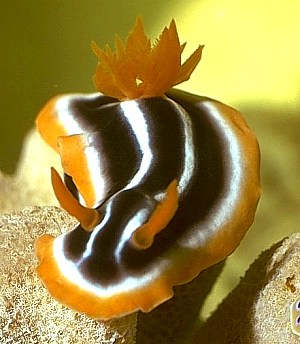
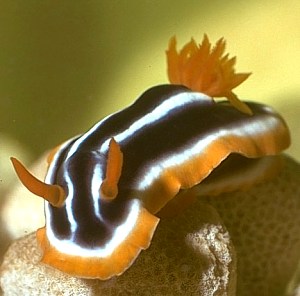
Chromodoris africana
Eliot, 1904
Order: NUDIBRANCHIA
Suborder: DORIDINA
Family: Chromodorididae
DISTRIBUTION
Typical specimens known from East Africa, Red Sea and western Indian Ocean.
PHOTO
Fungu Mkadya, off Kunduchi Beach, Dar es Salaam, Tanzania, January 1974, 73mm long alive. PHOTOS: Bill Rudman.
Colour as in the accompanying photos. The radular teeth have a number of morphological differences from similarly coloured animals Chromodoris cf. africana from the eastern Indian Ocean and western Pacific. In C. africana the innermost lateral tooth on each side has 3-4 inner denticles and no outer denticles and the other lateral teeth can have a few small outer denticles, but at the base of the tooth, or none. In Chromodoris cf. africana, however, the innermost lateral tooth has up to 5 inner and outer denticles, and the other lateral teeth have up to 7 prominent outer denticles.
References:
• Rudman, W.B. (1977) Chromodorid opisthobranch Mollusca from East Africa and the tropical West Pacific. Zoological Journal of the Linnean Society 61: 351-397.
• Rudman, W.B. (1982) The Chromodorididae (Opisthobranchia: Mollusca) of the Indo-West Pacific: Chromodoris quadricolor, C. lineolata and Hypselodoris nigrolineata colour groups.
Zoological Journal of the Linnean Society, 76: 183-241.
Rudman, W.B., 1999 (July 19) Chromodoris africana Eliot, 1904. [In] Sea Slug Forum. Australian Museum, Sydney. Available from http://www.seaslugforum.net/find/chroafri
Related messages
Chromodoris cf. africana? from Madagascar [2]
February 13, 2009
From: Sully Bachel
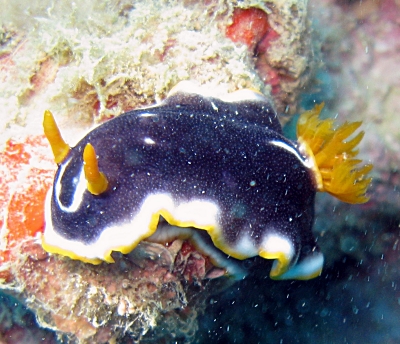
Concerning message #20981:
Hallo Bill
Here is another form of Chromodoris cf. africana observed on "Ile Ste Marie" on the East coast of Madagascar.
This one has a black mantle
Locality: Ile Ste Marie, 14 m, Madagascar, Indian Ocean, october 2008. Length: 30 mm. Photographer: Sully Bachel.
Best regards
Sully
s.bachel@orange.fr
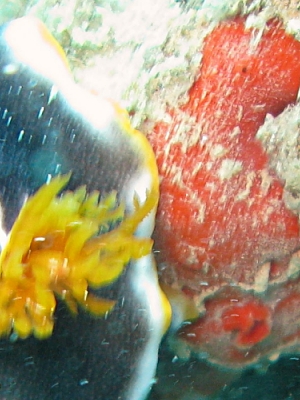
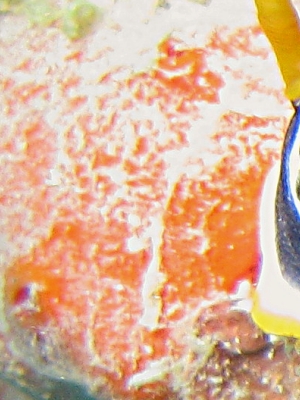
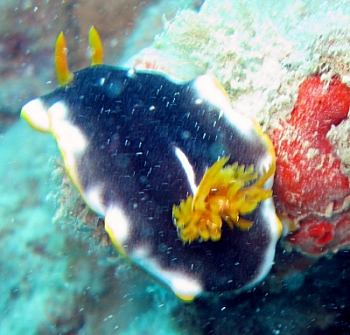
Dear Sully,
This is a good illustration of how difficult it is to sort out which are actual species and which are colour forms of species in this colour group of chromodorids, all characterised by an orange border and longitudinal black lines.
Compared with your earlier photos [message #22234] this animal differs in having a wider mantle, and the orange band around the mantle is right at the edge while in the earlier species it was in from the edge. Also this animal has traces of white rather than blue, and the gills are more numerous and often branched. I suspect this animal is a true C. africana rather than one that looks quite like it. That is not to say it is a 'perfect-looking' C. africana, but the wide mantle skirt and the numerous gills, as well as the absence of blue, make me 99% sure of its identity.
Interestingly it is associated with a red sponge, which could well be Negombata, one of the known food sponges of C. africana.
Best wishes,
Bill Rudman
Re: Chromodoris africana feeding?
August 13, 2007
From: Natasja Vandeperre
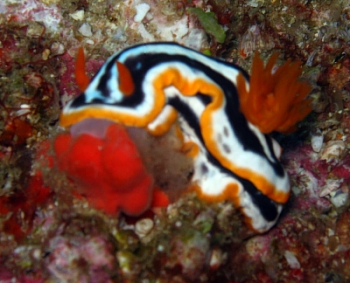
Concerning message #20411:
Hello Bill,
This picture isn't very sharp, but I think it's just what you're looking for. This Chromodoris africana is feeding, isn't it? But I thought I already sent it to you.
Locality: Tofo, Mozambique, Indian Ocean, 16 July 2007. Photographer: Natasja Vandeperre.
Greetings,
Natasja
postmaster@naaktslakken.be
Vandeperre, N., 2007 (Aug 13) Re: Chromodoris africana feeding?. [Message in] Sea Slug Forum. Australian Museum, Sydney. Available from http://www.seaslugforum.net/find/20440Dear Natasja,
Great picture - the bright red colour is a pretty good indication that this sponge is a species of Negombata, which seems to be the preferred food, or one of the preferred foods of a whole group of similarly coloured chromodorids. Your three records of this species feeding have more than doubled our knowledge on its biology.
Best wishes,
Bill Rudman
Chromodoris africana? from South Africa
August 10, 2007
From: Colin Ogden
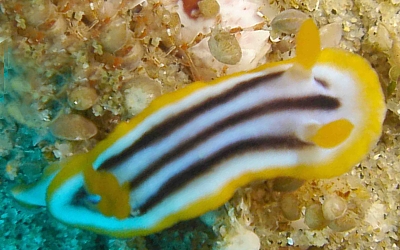
Hi Bill,
I have a creature which I originally assumed to be a Chromodoris africana, but on downloading appears to be different enough to query.
Locality: Sodwana Bay, 22 metres, South Africa, Indian, 31 October 2006, Reef. Length: 20 mm. Photographer: Colin Ogden.
best regards
Colin
scubaco@iafrica.com
Ogden C. M., 2007 (Aug 10) Chromodoris africana? from South Africa. [Message in] Sea Slug Forum. Australian Museum, Sydney. Available from http://www.seaslugforum.net/find/20280Dear Colin,
I am pretty sure this is a juvenile C. africana.
Best wishes,
Bill Rudman
Chromodoris africana from Tofo, Mozambique
August 9, 2007
From: Natasja Vandeperre
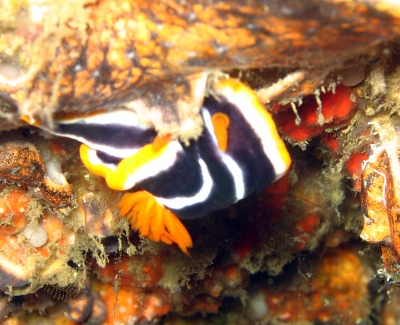
Dear Bill,
Here are two pictures of Chromodoris africana from Tofo, Mozambique.
Locality: Tofo, 20 m, Mozambique, Indian Ocean, 12 July 2007. Photographer: Natasja Vandeperre.
Greetings,
Natasja
postmaster@naaktslakken.be
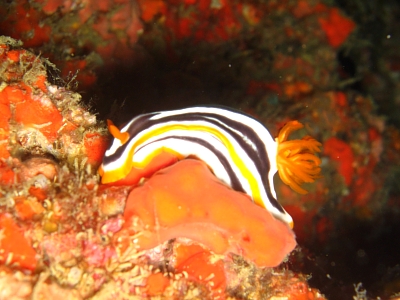
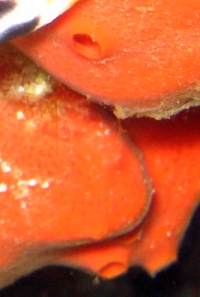
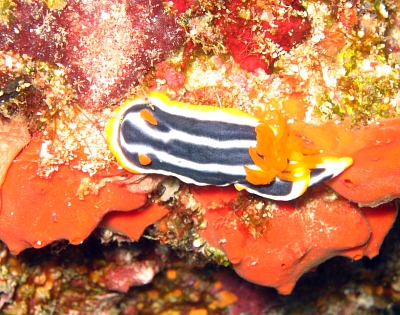
Dear Natasja,
Thanks for these photos. Getting so many photos of the similar-looking C. quadricolor, it's good to get some photos of typical C. africana to show its differences. From my experience of the two species in Tanzania many years ago, C. africana is one of those species with a wide, but thin, mantle skirt, while C. quadricolor has a narrower, but thicker, mantle skirt much firmer to the touch.
The interesting thing in your photos is that both animals are associated with a bright orange-red sponge which is almost certainly a species of Negomabata. We have only two feeding records of this species, so another two photos showing this association are very welcome.
Best wishes,
Bill Rudman
Chromodoris africana feeding
October 3, 2005
From: Lindsay Warren
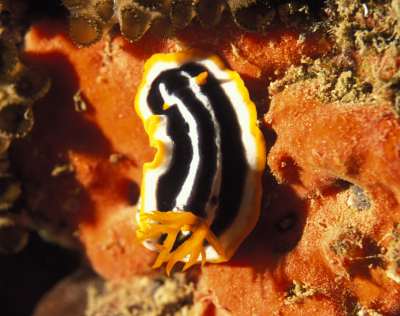
Dear Bill
I have been meaning to send these photos to you for some time to add to your list of feeding preferences for different species. I'm afraid I'm not able to identify the species of sponges but hope you or one of the sponge fundis might be able to shed some light.
This one is of a Chromodoris africana I photographed off Tany Kely, NW Madagascar. Not a particularly good shot as the opistho was tucked away in a very tight / awkward spot on the reef.
Locality: 'Gorgonian Valley', Tany Kely, NW Madagascar, Indian Ocean. Depth: 38 ft. Length: 40 mm. 25 January 2002. Steep drop-off around small island, varied benthic life. Photographer: Lindsay Warren
Many thanks as ever for all your work on the Forum!
All the best
Lindsay
LWarren@datonomy.co.uk
Warren, L.C.R., 2005 (Oct 3) Chromodoris africana feeding. [Message in] Sea Slug Forum. Australian Museum, Sydney. Available from http://www.seaslugforum.net/find/14894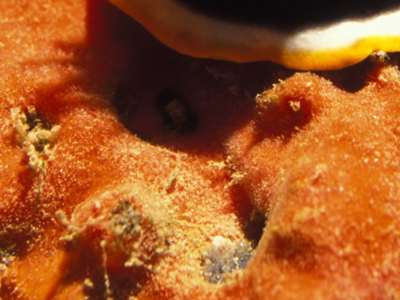
Dear Lindsay,
It's a while since I have heard 'fundi' - the Swahili word for expert. It brings back memories of 6 years working in Tanzania. Thanks for this photo. About a month ago I decided to stop adding new records to the manuscript I have in the final stages, but I am making an exception for this observation as it fits into a nice pattern. I am 99% sure of the identity of the sponge but will check with my sponge fundi. This is the first record we have of C. africana feeding so its a very pleasing addition.
Best wishes,
Bill Rudman
Chromodoris africana from Mayotte
December 10, 2003
From: Marina Poddubetskaia
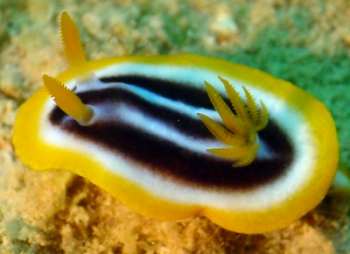
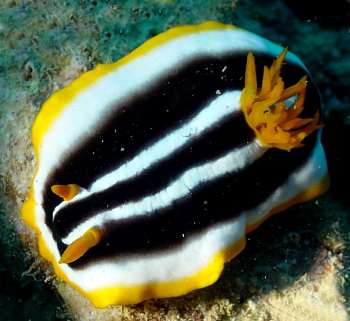
Dear Bill,
Could you confirm the ID of these specimens, please. I think they are both Chromodoris africana.
Upper Photo:
Date: November 11, 2003
Location: Handrema, Mayotte Island, Indian Ocean
Site: Banc Laclocheterie
Depth: 16m
Size: 15mm
Lower Photo:
Photo 2 :
Date: November 15, 2003
Location : Kongou, Mayotte Island, Indian Ocean
Site: Recif de Peitro
Depth: 14m
Size: 60mm
All the best to you,
Marina.
nembro@nembro.info
Poddubetskaia, M., 2003 (Dec 10) Chromodoris africana from Mayotte. [Message in] Sea Slug Forum. Australian Museum, Sydney. Available from http://www.seaslugforum.net/find/11614Dear Marina,
The large animal in the lower photo is definitely Chromodoris africana and I am pretty sure the small one is to. It seems to have the ovate mantle shape, with a broad skirt which is typical of that species. Both C. quadricolor and C. hamiltoni being more elongate.
Best wishes
Bill Rudman
Chromodoris kuiteri? from Gulf of Aqaba
November 17, 2003
From: Michael Levin
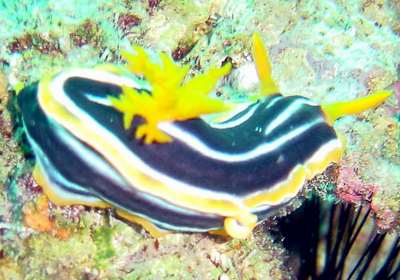
Hello,
The most common nudibranchs spotted by divers in Eilat(Aqaba) bay in are the 'pyjama slugs' - Chromodoris africana and Chromodoris quadricolor, but there is also third nudibranch with very similar color variation, but it much bigger and I find it very similiar to the Chromodoris kuiteri which known only from Queensland.
I would like to hear your knowledgeable opinion.
Best regards,
Michael Levin.
www.pbase.com/manta_ray/nudibranch
michael@scubadiving.com
Levin, M., 2003 (Nov 17) Chromodoris kuiteri? from Gulf of Aqaba. [Message in] Sea Slug Forum. Australian Museum, Sydney. Available from http://www.seaslugforum.net/find/11352Dear Michael,
From you photo and your mention that this is much larger than the other 'pyjama slugs' I would say this is C. africana which would suggest that one of the other smaller species is something else - Chromodoris hamiltoni perhaps?
I'm afraid the more photos I see of animals from the Indian Ocean and Red Sea the less confidence I have in being 'knowledgeable' about them. The only way to sort out how many species there are is to study living populations and see what patterns occur. It is possible that more than one species may have similar colour patterns, or two species may have variation in their colour patterns so sometimes they look idemtical and other times different. What we need is more information on what they eat and what their eggs ribbons look like. Different species may have anatomical differences but it's not much use knowing that if two different anatomies can have the same colour pattern
Best wishes
Bill Rudman
Chromodoris africana from Pemba
November 23, 2002
From: Paul Young
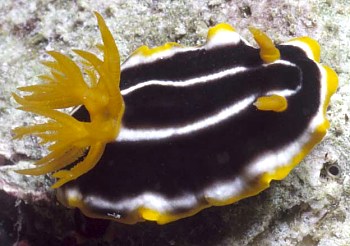
Dear Bill,
Here is one of the nudibranchs that Charlotte and I found at Pemba Island, off the coast of Tanzania, western Indian Ocean, in November/December 2001. The species from the west coast of Pemba are from dives we did with the Fundu Lagoon Resort to small nearby islands. This one, from the west side, was photographed on a night dive, 27 November, 2001.
Best wishes,
Paul Young
young@underwater.org
Young, P., 2002 (Nov 23) Chromodoris africana from Pemba. [Message in] Sea Slug Forum. Australian Museum, Sydney. Available from http://www.seaslugforum.net/find/8421Dear Paul,
This is the very appropriately named Chromodoris africana, which is only known from the western Indian Ocean.
Best wishes,
Bill Rudman
Variation of Chromodoris africana?
May 8, 2000
From: Valda Fraser
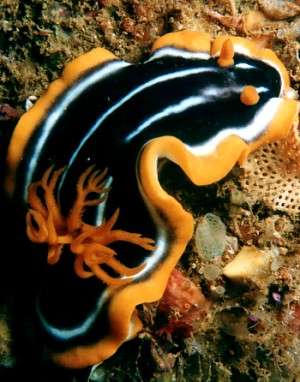
Dear Bill
I think this is a variation of Chromodoris africana. Do you agree?
Locality: Park Rynie - 25m south coast KwaZulu/Natal, SOUTH AFRICA
Date: 23April 2000
Size: 55mm
Regards
Valda
iti04937@mweb.co.za
Fraser, V., 2000 (May 8) Variation of Chromodoris africana?. [Message in] Sea Slug Forum. Australian Museum, Sydney. Available from http://www.seaslugforum.net/find/2363Dear Valda,
This is a fairly 'typical' example of the species, at least from my experience in East Africa and photos from the Red Sea. The white lines may be a bit narrower than normal but unlike some of the other species you have sent photos of, I feel confident that this is C. africana.
Best wishes,
Bill Rudman.
Chromodoris africana and 'look alikes'
January 27, 2000
From: Valda Fraser
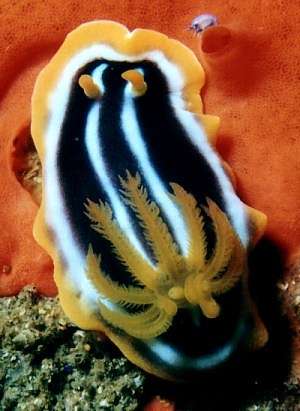
Dear Bill
These black and white nudibranchs are confusing me. There are 3 kinds that I see often. The first image is Chromodoris africana, or so I think. The second is Chromodoris cf. africana. The third one is a problem. What is it .. a half and half?
South Coast, KwaZulu-Natal, South Africa.
UPPER RIGHT: Hibberdene, April 1999, 45mm
LOWER LEFT: Hibberdene, June 1999. 50mm
LOWER RIGHT: Umkomaas, Jan 2000, 45mm
Regards
Valda Fraser
iti04937@mweb.co.za
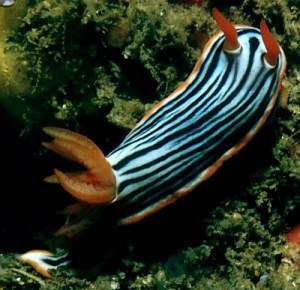
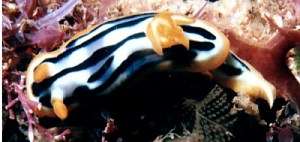
Dear Valda,
I'm afraid the chromodorids confuse most of us. No sooner do you think you have them sorted out than another colour pattern pops up! My comments on your three animals are:
UPPER RIGHT: Chromodoris africana.
LOWER LEFT: I'll put it with the Chromodoris cf. africana group but I think it may be different. It also has similarities in colour to C. striatella and C. lineolata.
LOWER RIGHT: C. strigata.
I have copied relevant parts of your message to the other relevant pages and added some comments. In general, if these species are relatively common it would be great to get some photos of them on their food sponges and of their egg ribbons to see how they differ. I realise determining which sponges are being eaten is not always easy, but if you inevitably find a species on or at the edge of the same sponge species its probably a pretty good indication. Similarly with identifying who laid an egg mass - the only sure way in the field is to catch them being laid.
Thanks for the great photos and interesting animals.
Best wishes,
Bill Rudman
Chromodoris africana - appendage?
November 9, 1999
From: Valda Fraser
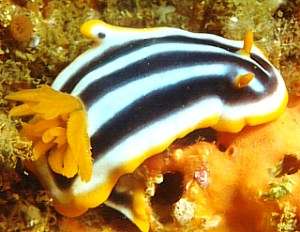
Dear Bill
I would like to know if it is common for Chromodoris africana to have an extra bit on its left-hand side, including beauty spot! I have only seen one specimen like this.
Regards
Valda Fraser
iti04937@mweb.co.za
Fraser, V., 1999 (Nov 9) Chromodoris africana - appendage?. [Message in] Sea Slug Forum. Australian Museum, Sydney. Available from http://www.seaslugforum.net/find/1506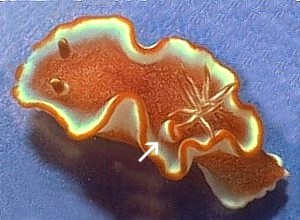
Dear Valda,
The extra growth on your Chromodoris is unusual, but its surprising how many nudibranchs you can find with 'developmental' faults like this. Sometimes chromodorids are found with their gills sitting underneath the mantle flap, and sometimes you can find nudibranchs with their rhinophores merged.
Here's a photo of a 32mm Glossodoris rufomarginata from Dar es Salaam, with a peculiar cylindrical growth complete with a marginal colour band.
Best wishes,
Bill Rudman.
Chromodoris africana
July 19, 1999
From: Bill Rudman
Here is a page on Chromodoris africana to compare with Bob Bolland's photo.
Bill Rudman.
